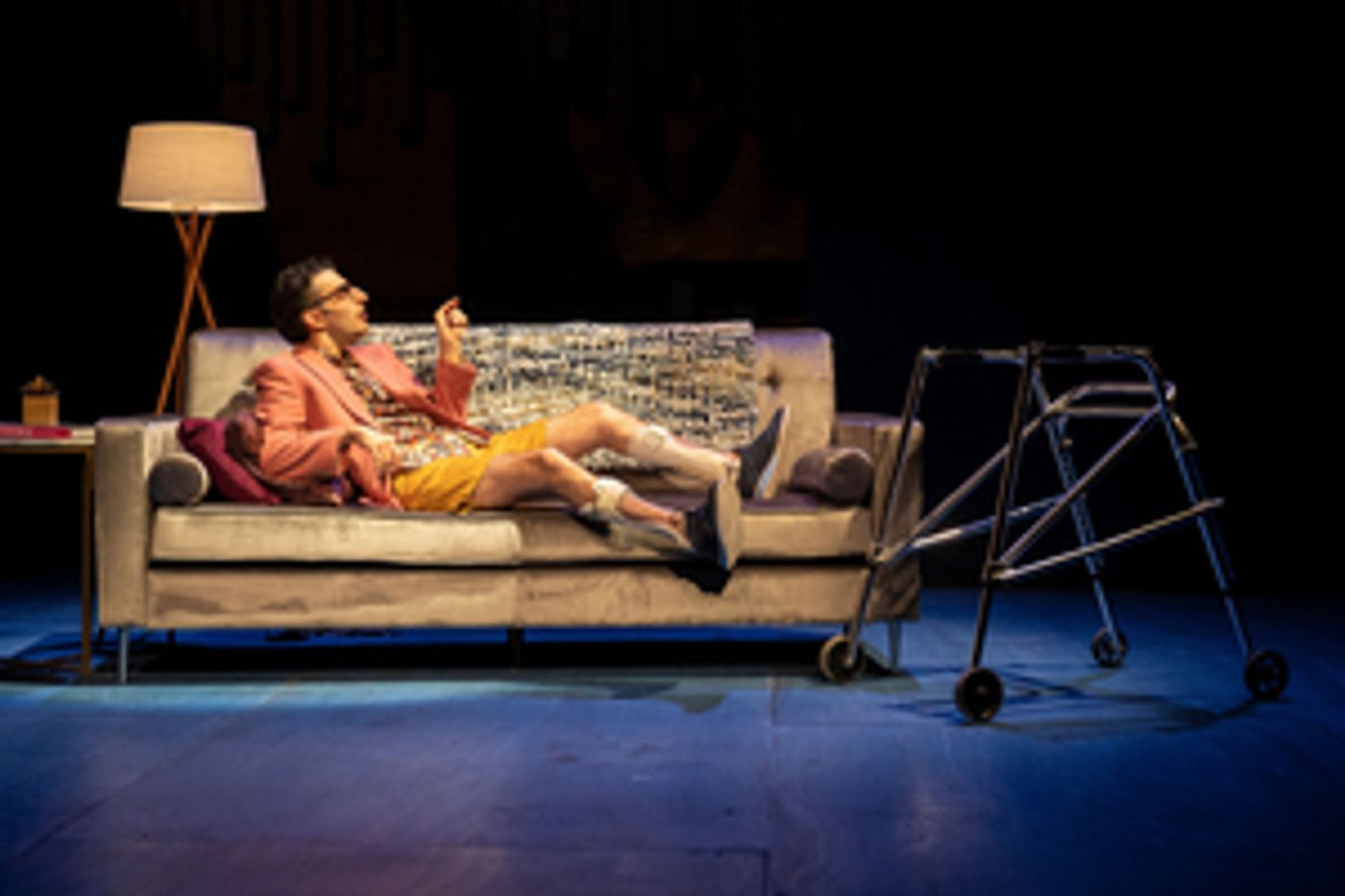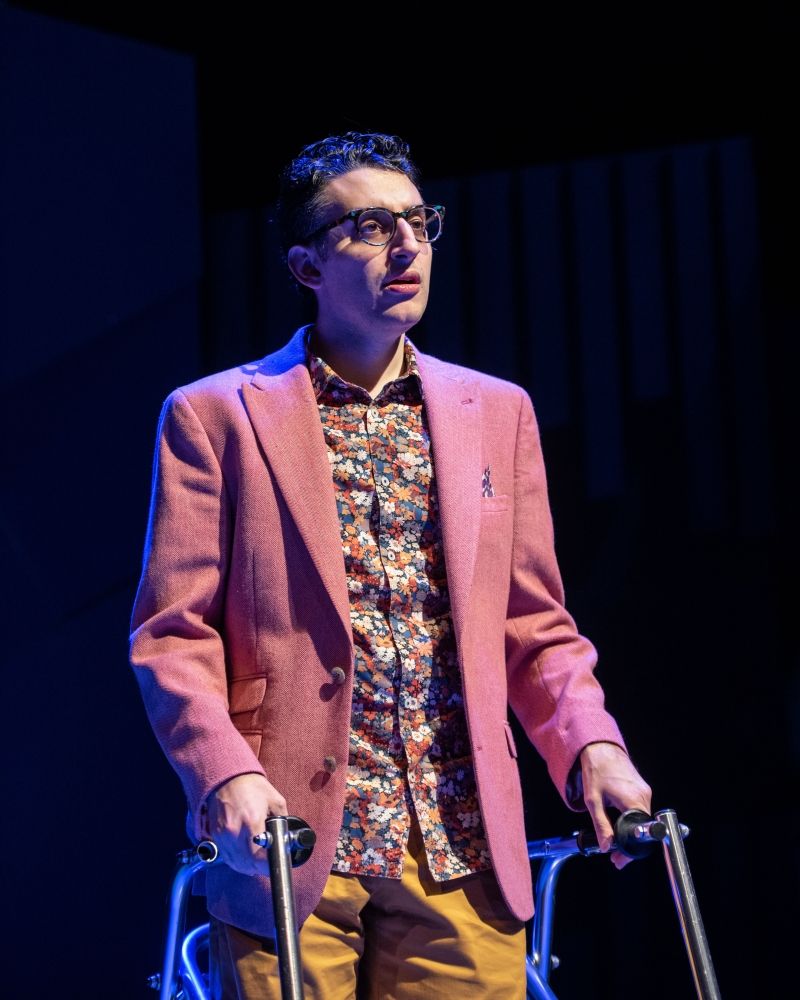Review: HI, ARE YOU SINGLE? at Woolly Mammoth
The production runs until April 10, 2022

Hi, Are You Single? is a one-man show that explores intimacy, hypocrisy, sex, and slow dancing with strangers. Written and performed by Ryan J. Haddad, the show exists at the intersection between queerness and living with a disability. Ryan is a gay man with cerebral palsy, and his experiences with dates and hooks up are the focus of the piece.
The show starts off with Ryan, quite exposed on a couch, having a sensual video call with a man from a dating app. It provides some expository facts and jokes before he (literally) gets caught with his pants down, the proverbial wall is broken, and Ryan begins addressing the audience.
Which he never really stops doing. Being a one-man show, direct address is expected, but Ryan and Laura Savia (the director) incorporated a lot of play with the audience. Asking questions, taking polls, etc, which was pretty engaging, and always creates a sense of group within the audience. Some of the questions were quite risqué, and one could see audiences potentially feeling slightly uncomfortable, though this particular audience was more than happy to engage. Ryan was quite charming, calling the audience his "darlings" and complimenting them throughout the show.
The play consists mainly of stories told in the past tense by Ryan about his interactions with other gay men. Quite a few take place in gay bars and clubs, where he illustrates the ups and downs of navigating both the physical and social environments with a disability and a walker. While detailing his night-life experience, Ryan explores how other queer men see him and his cerebral palsy, particularly in terms of their attraction toward him, and/or combability with him sexually. He shows how he is forced by an inaccessible world, to take a unique approach to night-life, and shares with the audience, some of his methods.
The lighting (designed by Colin K. Bills), set (designed by Lawrence E. Moten III), and sound (designed by Tosin Olufolabi) are the most exciting here. The sole wall of the show, which is angular, simple, and contemporary, becomes long shelves lined with various bottles of liquor. The lights pulse, change color and expand with the music, which emulates generic electronic club tunes. Each locale is met with a slight change to the aforementioned elements, done quickly in succession which adds a bit of a comedic beat at each cue.
Another moment where the design shines is near the end of the show when Ryan recounts a sexual encounter he had with an older man. It's nothing he hasn't given the audience before however Ryan slows his pace, smoothes his tone, and delivers a monologue.
A simple light shines down on him, the rest of the stage darkens. It is simple, and it is effective. Which goes for much of the design. The set is sparse, there is nothing there that doesn't need to be, which is often the case for good, functional sets. The costuming (also by Lawrence E. Moten III) is minimal- one set of everyday banal clothing, accented by a to-be-mentioned pink suit jacket.
The show is sewn tightly with humor, featuring very frequent jokes. There seemed to be, at least for a large portion of the show, a sort of rhythm. Ryan would say a few sentences- part of a story, an anecdote, etc, end with a joke, usually a quip or one-liner, and transition into the next related piece of information.
This pattern (while of course not used for the entirety of the show) was effective in getting laughs and keeping a good pace. It was used as almost a form of punctuation, which usually was effective, or at least not a problem, however, there were times when something more profound, or intimate would be uttered by Ryan, and then any reflection or stewing by the audience would be undercut with a joke, and then swiftly ushered onto the next concept, thought, or idea. While not grievous, it left little room at times for introspection or changes in pace.
The triumphs of Ryan's life are just as important as the tribulations throughout the show. The audience, who may not be familiar with living in an inaccessible world, is exposed to the prejudices of the men Ryan meets, their ignorance, their ableism, and perhaps even their honesty. However one also gets to share in his tender, brighter moments. The show makes a point to not squander its attention on a polarized view. It presents the heavier, darker moments, with a brighter, funnier package. They're able to coexist.
One of the highlights of the show (slight spoilers ahead) is when Ryan calls onto the stage an audience member to slow dance and talk with. This is precedented by a salmon coat jacket gracefully floating down from the fly system for Ryan to adorn, which was quite absurd and comical. While Ryan dances with the audience member they muse about relationships, love, dating. It is also an intriguing look into the show's production history, as right after, Ryan details some of his favorite moments dancing with strangers.
And strangers (aka the audience) are a very large part of this show. Outside of the actual play, the experience started as soon as one got their ticket. In the lobby outside of the theater, there were multiple stations (if you will) where the audience was able to interact with each other and the main themes of the show. One could vote for their favorite dating app with a marble, write about how their identity affects their love life, and vote on a sticker pole with questions like "are you friends with your ex?"
Being a bit reductive, there were two large asks of the audience for this show. One was what the show was advertised on, to reflect on and learn about the way sexuality intersects with disability- the audience is invited, through Ryan's experience, and their own, to meditate upon their own biases and notions when it comes to these two facets.

In this manner, the show could get the slightest bit didactic. It should be noted however, this is difficult to pull off subtly as audiences all have varying knowledge (assumedly vastly varied) of life with a disability, particularly cerebral palsy, and while yes, slightly didactic, things were not abrasive.
The other facet was more subtle and had to do with hypocrisy and judgment, and wasn't presented until later in the show. Before the retelling of a specific encounter, the piece explored thoughts directly related to each other. Anecdote, joke, story, reflection, all relating to each other, presented one after the other, sometimes chronologically, sometimes not. However, after this specific story, it became clear that there was an arc for this characterized version of Ryan.
Ryan was forced to reflect upon his own actions and instincts after being confronted by one of the numerous men from the stories about his ability to judge others as compared to their ability to judge him. Ryan thinks back to a boy whom he rejected due to his HIV status.
The crux and climax of the show exist here. Ryan and the audience were able to flip positions and one judge him by proxy of this particular boy, and the other men he's interacted with. It is an epiphany of sorts and lingers till the end of the show.
While this is the start of an arc (if you will) it never quite get finished, which is slightly unsatisfying, though seemingly part of the point. Ryan explains how his life (particularly his love life) is unchanging and unfinished. There is a lot he has not figured out, and a lot he wants to explore. And perhaps he will write another show about it, or perhaps leave us with the messy chaos of this piece. Who's to say?
The themes/topics are very important ones to discuss, and Ryan has done the work of bringing them to an audience and educating them. The agenda is very transparent. Ryan wants to show audiences people living with disability enjoy sex and are sexy.
At its best, Hi, Are You Single? is a charming, deeply intimate look at one person's experience with love and all their identities. At its worst, it is a quickly paced, pretty funny, stand-up-esque series of anecdotes. It is deeply of its time, of the playwright, and quite sensual. Imperfect and important, check out Hi, Are You Single? at Woolly Mammoth through April 10th. It comes in at about an hour with no intermission, and viewers should be advised the show deals with themes of ableism, and contains strong sexual content. Information on tickets including shows with ASL interpretation and audio descriptions can be found on Woolly Mammoth's website at https://www.woollymammoth.net/event/hi-are-you-single/.
All photo credit goes to Teresa Castracane Photography.
Reader Reviews
Videos

